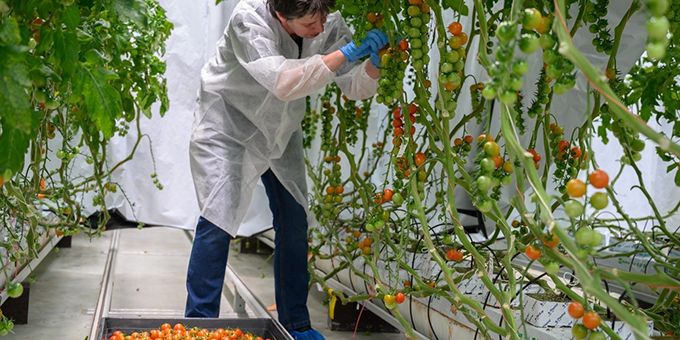Five-month growing trial on high-wire tomatoes conducted by Wageningen and Vortus demonstrates full-spectrum LEDs from Fluence by OSRAM are a viable solution to replace legacy HPS fixtures.
 Wageningen University Proves Viability of Fluence by OSRAM LEDs
Wageningen University Proves Viability of Fluence by OSRAM LEDs

News From | Fluence by OSRAM
Wageningen University and Research (WUR), in cooperation with Fluence by OSRAM and Vortus, has released initial results of a cultivation trial analyzing the viability of full-spectrum LED lighting solutions, using Fluence PhysioSpec Greenhouse™ spectrum, in comparison to legacy high-pressure sodium (HPS) greenhouse lighting fixtures. Preliminary data shows PhysioSpec Greenhouse is up to 11% more effective than HPS in yield for certain tomato cultivars, with the added benefit of being more energy efficient than HPS fixtures.
“The initial results of this trial show growers can cultivate tomatoes as effectively with PhysioSpec Greenhouse as you can under HPS, possibly with a better yield, and with shorter stems,” said Dr. Ep Heuvelink, associate professor, WUR. “Of the tomatoes grown under PhysioSpec Greenhouse, when compared to the HPS control environment, the WUR team saw the crop developed well and fruits had similar dry matter content. In fact, fruit yield is a bit higher in the LED sections for the Tomagino cultivar, which is a welcome benefit when considering the energy reduction LEDs naturally exhibit over HPS technology.”
Dr. Heuvelink, and his team at WUR, tested PhysioSpec Greenhouse in comparison to HPS lighting from a recognized vendor. The research was conducted on Tomagino and Merlice tomato cultivars. WUR will publish the full data set later this year.
“Current practices use HPS technology as the sole source for supplemental lighting in greenhouses and the WUR trial proves this should not be the case,” said Barend Lobker, director and owner, Vortus. “Growers have been reluctant to transition to LEDs because they are uncertain if LEDs can be as effective for cultivation and the WUR trial eliminates any doubts around the capabilities of full spectrum LEDs.”
“This is a very exciting result for the application of full-spectrum LED technology in greenhouse tomato production. It demonstrates that even without any other environment optimization for LED solutions, LEDs can match, or even out-perform legacy lighting fixtures for commercial growers,” said Haris Ouzounis, horticulture service specialist and senior photobiologist, Fluence by OSRAM. “Upcoming studies from Fluence into the influences of light quality, distribution, and intensity, as well as optimizations to the rest of the environment should demonstrate improvements in productivity compared to legacy production practices.”
Further Collaborations in Science and Research
Cooperating with recognized thought leaders around the world is a top priority for Fluence by OSRAM. This initial trial with WUR is the first in a series of results Fluence will release over the coming months. Additionally, Fluence is advancing several other initiatives with research centers, universities, and organizations around the world to further develop best practices and forward-looking applications for the industry.
“Basing our solutions on research and science are fundamental differentiators which sets Fluence apart,” said David Cohen, chief executive officer, Fluence by OSRAM. “We are proud to be working with Wageningen University and to join the WUR Club of 100, to further extend the world’s understanding of critical and fundamental horticultural research. Greenhouses are a significant source of nutritious fruits and vegetables and WUR’s ground-breaking research will empower more countries to cultivate high-quality crops in an energy-efficient way.”
About Fluence by OSRAM
Fluence Bioengineering, Inc., a wholly-owned subsidiary of OSRAM, creates the most powerful and energy-efficient LED lighting solutions for commercial crop production and research applications. Fluence is the leading LED lighting supplier in the global cannabis market and is committed to enabling more efficient crop production with the world’s top vertical farms and greenhouse produce growers. Fluence global headquarters are based in Austin, Texas, U.S.A., and its EMEA HQ in Rotterdam, Netherlands. https://fluence.science
About Wageningen University and Research
The mission of Wageningen University and Research is “To explore the potential of nature to improve the quality of life.” Under the banner Wageningen University & Research, Wageningen University and the specialized research institutes of the Wageningen Research Foundation have joined forces in contributing to finding solutions to important questions in the domain of healthy food and living environment. With its roughly 30 branches, 5,000 employees and 10,000 students, Wageningen University & Research is one of the leading organizations in its domain. The unique Wageningen approach lies in its integrated approach to issues and the collaboration between different disciplines.
About Vortus bv
Established in 1982, Vortus bv is an independent greenhouse consulting firm which services clients from around the world. The team is comprised of ten consultants, which specializes in providing technical advice regarding climate, irrigation, nutrition, energy management, and labor management for greenhouse environments.
The content & opinions in this article are the author’s and do not necessarily represent the views of AgriTechTomorrow
Comments (0)
This post does not have any comments. Be the first to leave a comment below.
Featured Product

